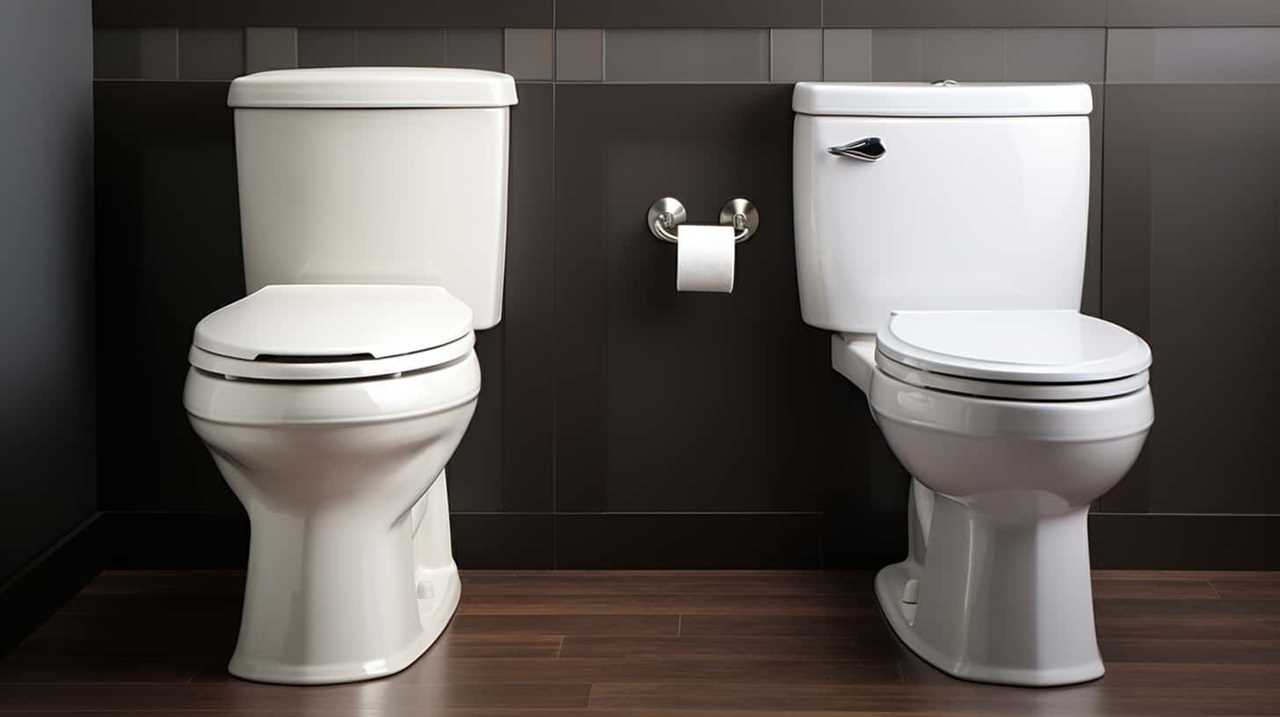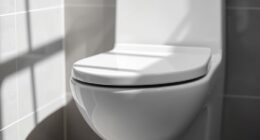Ever curious about what to do when you need to flush a toilet and there’s no water flowing? Don’t worry! We have some clever tricks up our sleeve to help you out.
From the Bucket Method to DIY Gravity Flush System, we’ll walk you through step-by-step.
Need a portable toilet option or a natural alternative? We’ve got those too!
In this article, we’ll delve into the technical details and provide you with the mastery you desire.

So, let’s dive in and discover how to tackle this common challenge head-on.
Key Takeaways
- The bucket method and using a trash bag are simple and effective solutions for areas with water scarcity or emergencies. They involve pouring water directly into the toilet bowl or lining the bowl with a trash bag and disposing of it properly.
- DIY gravity flush systems can be used as a flushing mechanism without running water. These systems rely on the force of gravity, with a tank placed above the toilet that fills with water and releases it into the bowl.
- Portable toilet options include using chemicals to break down waste and control odors or utilizing composting toilets that use natural processes to turn waste into compost. Portable toilet chemicals are added to the holding tank, while composting toilets require more maintenance but minimize environmental impact.
- Natural alternatives for flushing a toilet without running water include utilizing water collected from rain or other sources, using homemade composting toilets that utilize organic materials and sawdust to break down waste, using waterless urinals that eliminate the need for flushing, and exploring gravity and special sealant-based systems to prevent odors and maintain cleanliness. Other toilet alternatives include chemical toilets, vacuum toilets, and incinerating toilets.
The Bucket Method
To flush a toilet when there’s no running water, we can utilize the bucket method by pouring water directly into the bowl. This method is a simple yet effective way to maintain sanitation in areas with water scarcity or during emergencies. By using this technique, we can conserve water while still ensuring proper hygiene.
To implement the bucket method, fill a bucket with water and pour it directly into the toilet bowl, aiming for the center. The force of the water will create a flushing effect, removing waste and maintaining cleanliness. This method isn’t only practical but also environmentally friendly, as it reduces water consumption.
However, if the bucket method isn’t feasible, we can explore alternative solutions such as using a trash bag as a makeshift toilet.

Using a Trash Bag
We can employ the trash bag method as an alternative solution to flush a toilet when there’s no running water. Using plastic bags is a practical way to simulate the flushing mechanism. Here’s how it works:
- First, line the toilet bowl with a large, sturdy trash bag. Make sure to secure it tightly around the rim.
- Next, use the toilet as you normally would, but instead of flushing, tie up the bag and dispose of it properly.
- This method allows for waste containment and disposal without the need for water.
- It’s important to note that this is a temporary solution and should be used sparingly.
- However, if the situation persists, it may be necessary to explore more sustainable options, such as a DIY gravity flush system.
Transition: Now that we’ve covered the trash bag method, let’s move on to discussing the DIY gravity flush system.
DIY Gravity Flush System
Continuing our exploration of alternative methods for flushing a toilet when there’s no running water, let’s now delve into the DIY gravity flush system.
When it comes to flushing a toilet without running water, there are two main types of systems to consider: gravity flush and pressure flush.

In a gravity flush system, the force of gravity helps to create the necessary pressure to flush waste down the drain. This system relies on a tank placed above the toilet, which fills with water and then releases it into the bowl, creating a flushing action.
Troubleshooting common toilet flushing issues in a gravity flush system often involves checking for clogs, ensuring the tank is properly filled, and adjusting the water level.
Now that we’ve explored the DIY gravity flush system, let’s move on to discussing portable toilet options.
Portable Toilet Options
Now let’s explore our options for portable toilets in situations where there’s no running water.

When it comes to portable toilets, there are two main options to consider: portable toilet chemicals and composting toilets.
Portable toilet chemicals are specifically designed to break down waste and control odors. They typically come in liquid or powder form and are added to the holding tank of the portable toilet. These chemicals contain enzymes and bacteria that help break down solid waste, making it easier to dispose of later.
On the other hand, composting toilets are a more environmentally friendly option. They use natural processes to break down waste into compost, which can then be used as fertilizer. Composting toilets require a bit more maintenance, but they’re a great option for those looking to minimize their environmental impact.
As we move forward, let’s explore some natural alternatives for toilet flushing.

Natural Alternatives
One possible natural alternative for flushing a toilet when there is no running water is to utilize water collected from rain or other sources. However, there are also other options available that do not require water at all. Two such alternatives are homemade composting toilets and waterless urinals.
Homemade composting toilets are a sustainable and eco-friendly solution for flushing without running water. These toilets use a combination of organic materials and sawdust to break down waste into nutrient-rich compost. The compost can then be used as fertilizer for plants, closing the loop and reducing water usage.
Waterless urinals, on the other hand, are specifically designed to eliminate the need for flushing. They use a combination of gravity and a special sealant to prevent odors and keep the urinal clean. This not only saves water but also reduces the need for maintenance and plumbing.
In summary, when faced with the challenge of flushing a toilet without running water, considering natural alternatives such as homemade composting toilets and waterless urinals can provide sustainable and efficient solutions.

| Natural Alternatives | Description | Advantages |
|---|---|---|
| Homemade composting toilets | Utilizes organic materials and sawdust to break down waste into compost | Sustainable, reduces water usage |
| Waterless urinals | Uses gravity and a sealant to eliminate the need for flushing | Saves water, low maintenance |
Frequently Asked Questions
Can I Use Any Type of Bucket for the Bucket Method?
We can use various types of buckets for the bucket method. However, it’s important to consider hygiene and choose a bucket that is clean and dedicated for this purpose.
How Do I Dispose of Waste When Using a Trash Bag as a Toilet?
When using a trash bag as a toilet, disposal options depend on local regulations. Proper disposal ensures hygiene and prevents contamination. Consider using designated waste disposal facilities or following guidelines for waste management to ensure public health and safety.
Is It Difficult to Build a DIY Gravity Flush System for a Toilet?
Building a gravity flush system for a toilet can be challenging, but with DIY toilet options, it is possible. By understanding the mechanics and following detailed instructions, you can create a functional and efficient flushing system.
What Are the Best Portable Toilet Options for Emergencies or Camping?
When it comes to portable toilet options for disaster preparedness or outdoor events, there are several choices available. These options ensure sanitation and convenience in situations where running water may not be accessible.

Are There Any Natural Alternatives to Flushing a Toilet When There Is No Running Water?
When there is no running water, natural alternatives to flushing include using composting toilets. Composting toilets use a combination of organic materials and microorganisms to break down waste, turning it into compost.
Conclusion
In conclusion, when faced with the challenge of flushing a toilet without running water, it’s essential to explore alternative methods. These methods include the bucket method, using a trash bag, or even constructing a DIY gravity flush system.
Additionally, portable toilet options and natural alternatives can provide temporary solutions.
By employing these techniques, individuals can maintain hygiene and cleanliness. This ensures a comfortable and odor-free environment even in situations where traditional plumbing is unavailable.











